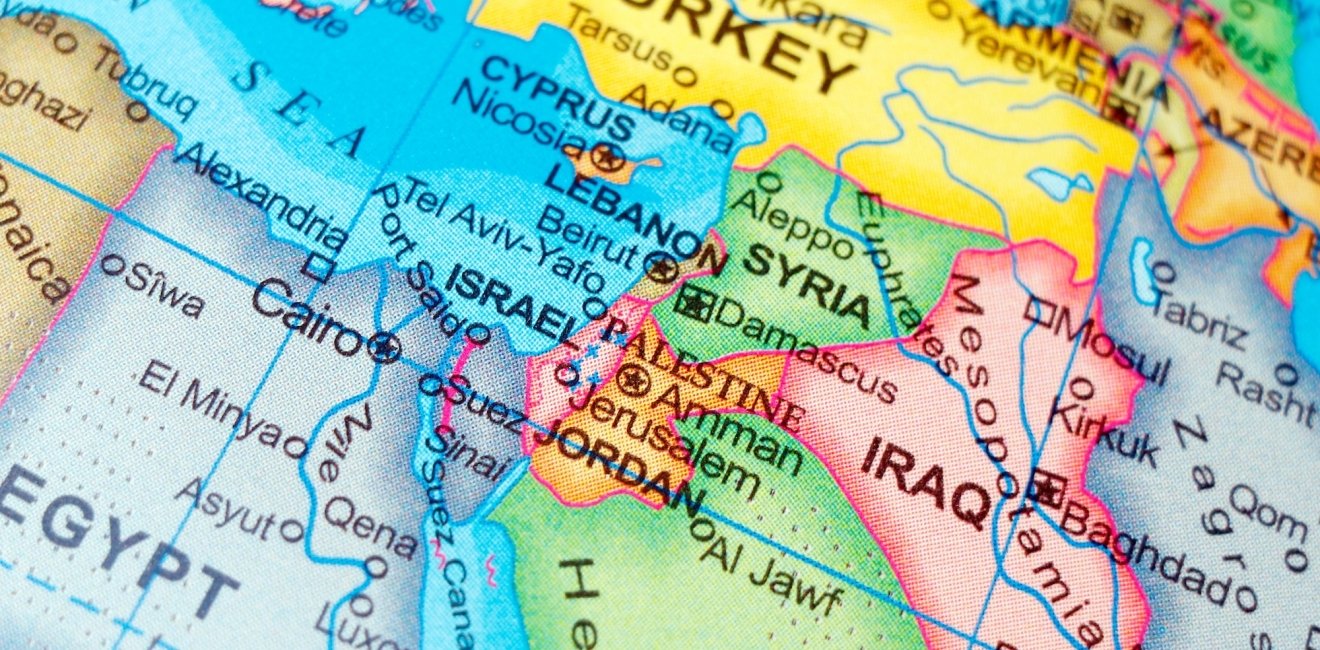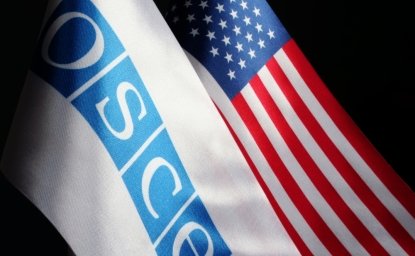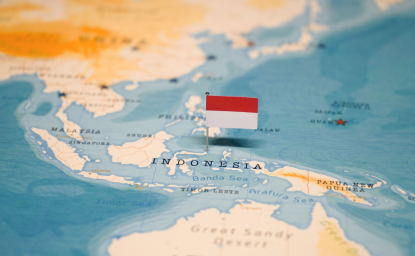The Middle East has been the most volatile part of the world since the mid-20th century, with multiple conflicts among disparate rivals. Some erupted over domestic disputes, others over regional competition, with spillover drawing in major world powers. Israel fought four major wars with Arab neighbors, including Egypt, Syria, and Jordan, between 1948 and 1973. But since the creation of the Palestine Liberation Organization in the mid-1960s, it has increasingly faced challenges from militias or non-state actors, eventually also including Hezbollah in Lebanon, Hamas in the Palestinian territories, and the Houthis in Yemen. The militias became major military players in the 1980s, then evolved into influential political parties in the 1990s and 2000s. In the 21st century, they have been the most consistent threat to Israel.
The undercurrent in all these conflicts was the escalating tensions between the United States and Iran.
By 2024, 10 conflicts flared across the region. Israel faced two frontlines in the south against Hamas and in the north against Hezbollah. Both were members of the so-called “Axis of Resistance,” a network of Shiite movements armed, trained, and financially supported by Iran. Tensions also played out between Israel and the wider Arab world. In Iraq and Syria, other Iranian-backed militias attacked US forces deployed to help contain the remnants of ISIS after the Islamic State collapsed in 2019. Yemen was involved in three wars—a civil war at home, a regional confrontation with Saudi Arabia, and attacks on international shipping in the Red Sea. The undercurrent in all these conflicts was the escalating tensions between the United States and Iran. The following is the background on all ten conflicts.
Israel and Hamas
With the PLO sidelined after Israel’s invasion of Lebanon in 1982, tensions between the Palestinians and Israel deepened in the occupied territories of Gaza and the West Bank. The first Intifada erupted in 1987 after an Israeli military truck killed four Palestinians in Gaza and lasted until 1993. The protests gave rise to Hamas, an Islamist movement that shifted the goals of the Palestinian movement. It decreed, “There is no solution for the Palestinian question except through jihad. Initiatives, proposals, and international conferences are all a waste of time and vain endeavors.” The first Intifada ebbed with the 1993 peace agreement between Israel and the PLO.
A second Intifada erupted in 2000 after the collapse of U.S.-led talks between Israel and the PLO at Camp David. Violent protests continued until 2005 when Israel withdrew unilaterally from Gaza. In the 2006 Palestinian elections, Hamas won the majority of seats in parliament in a major political upset over Fatah, the dominant PLO faction. Amid disputes among the Palestinians, Hamas seized control of Gaza while Fatah led the West Bank government. Hostility between Israel and Hamas flared into conflicts in 2008, 2012, 2014, 2018, 2021, 2022 and 2023. On Oct. 7, 2023, Hamas launched cross-border raids in the deadliest attack on Jews since the Holocaust. Israel’s military response killed tens of thousands of Palestinians and destroyed more than half of Gaza’s buildings.
Israel and Hezbollah
Israel’s invasion of Lebanon in 1982 forced thousands of PLO fighters to flee to other countries. Its ongoing occupation sparked fury among Lebanon’s Shiites and the creation of Hezbollah, a militia armed, trained, and aided by Iran. It was underground for a decade, then emerged to run for parliament in 1992. Hezbollah attacked Israeli forces throughout their eighteen-year occupation of Lebanon. Under pressure from suicide bombings and attacks, Israel opted to withdraw in 2000—for the first time in the midst of a war without a peace agreement.
At the time, then-Israeli Defense Minister Yitzak Rabin reflected, “Among the many surprises, and most of them not for the good, that came out of the war in Lebanon, the most dangerous is that the war let the Shiites out of the bottle. No one predicted it. I couldn’t find any intelligence report.” He added, “In my opinion, the Shiites have the potential for a kind of terrorism that we have not yet experienced.”
In 2006, a cross-border raid by Hezbollah sparked a 34-day war with Israel. For all the death and destruction, Hezbollah was able to rearm and rebuild. By 2024, it had an estimated 150,000 rockets and missiles pointed at Israel. After the Hamas attack on Israel on Oct. 7, 2023, Hezbollah launched more than 700 rockets or missiles into northern Israel in the first three months—in sympathy with its Palestinian allies.
Israel and Iran
Israel and Iran had diplomatic and economic relations, including oil and arms dealings, until the monarchy was ousted in the 1979 revolution. Ayatollah Ruhollah Khomeini, the revolutionary leader, condemned Israel as an “enemy of Islam” and the “Little Satan” (while the United States was the “Great Satan). Despite a back-channel arms deal with Israel during Iran’s eight-year war with Iraq, tensions steadily escalated. After President Mahmoud Ahmadinejad said in 2005 that Israel should be wiped off the map, Israeli Vice Prime Minister Shimon countered in 2006, “The president of Iran should remember that Iran can also be wiped off the map.” Iran’s threats persisted. In 2010, Supreme Leader Ayatollah Ali Khamenei tweeted, “Israel is a hideous entity in the Middle East which will undoubtedly be annihilated.”
Tensions have played out, particularly over Tehran’s support for militias in the Axis of Resistance. Iran helped create Hezbollah and helped it become the largest in the Middle East and one of the largest non-state actors in the world. The Islamic Republic also armed and aided other militias—a collection of Shiite militias under the rubric of the Popular Mobilization Forces in Iraq, local Muslim militias in Syria, both Hamas and Palestinian Islamic Jihad in the Palestinian Authority, and the Houthis in Yemen. All share the strategic objective of eliminating Israel.
The biggest flashpoint has been Iran’s nuclear program as it advanced over the decades. For decades, Israeli leaders have vowed to stop or destroy it. Between 2010 and 2012, four nuclear physicists were assassinated in covert operations; the father of Iran’s nuclear program was assassinated in 2020. Iran claimed Israeli agents were responsible. Israel was also reportedly complicit in the Stuxnet virus that infected and delayed Iran’s centrifuge program in 2010. Key Israeli leaders opposed the 2015 Iran nuclear deal brokered by the world’s six major powers and were pleased when President Trump abandoned it in 2018. In his address to the UN General Assembly in 2023, Prime Minister Benjamin Netanyahu vowed, “As long as I’m prime minister of Israel, I will do everything in my power to prevent Iran from getting nuclear weapons.”
For decades, the 22 members of the Arab League vowed not to deal in any form with Israel until the creation of a Palestinian state.
Israel and the Arab World
For decades, the 22 members of the Arab League vowed not to deal in any form with Israel until the creation of a Palestinian state. The pact was broken when Egypt and Israel signed the Camp David Accords in 1978. In 1993, the PLO and Israel signed the Oslo Accord, which led to the establishment of the Palestinian Authority in the West Bank and Gaza. It was intended to be a first step toward the creation of a Palestinian state, although all subsequent U.S.-led efforts failed to reach a final settlement. Jordan and Israel recognized each other in 1994. Between 2020 and 2021, the Abraham Accords led to phased normalization between Israel and Bahrain, the United Arab Emirates, Morocco, and Sudan. But progress in normalizing relations between Israel and Saudi Arabia—the guardian of Islam’s holy places and the most stalwart of the Arab states—stalled after the war between Hamas and Israel erupted in 2023.
Three Houthi Wars in Yemen
The Houthi rebel movement emerged in the 1990s among a tribal Shiite sect committed to reviving cultural and religious traditions. After the Arab Spring uprising ended the 22-year rule of President Ali Abdullah Saleh, Yemen imploded politically. The civil war erupted in 2014 after Houthi insurgents seized Sanaa, the capital and power from the government supported by neighboring Saudi Arabia.
The civil war went regional in 2015 when a Saudi-led coalition imposed an economic blockade of Yemen and launched massive air strikes on Houthi-controlled areas. It supported the government that fled Sanaa. The conflict became a virtual proxy war between Saudi Arabia, a predominantly Sunni nation, and Iran, the largest Shiite country in the region, which had armed and aided the Houthis. The Saudi campaign continued into March 2023, when diplomacy led by Oman attempted to mediate a ceasefire. It stalled after the outbreak of the war in Gaza.
In October 2023, the Houthis launched a third front on commercial shipping in the Red Sea, a strategic waterway through which almost a third of international shipping passes en route to the Suez Canal. They claimed the drone and missile campaign was in support of their allies in Hamas, although the vast majority of ships targeted had no connections to Israel. The United States responded by mobilizing two international coalitions. Operation Prosperity Guardian committed to protecting international shipping. Operation Poseidon Archer intercepted Houthi drones and missiles over the Red Sea and attacked their military sites in Yemen.
Iran Proxy Attacks on US Forces in Iraq, Syria, and Jordan
The United States continued to deploy military forces to contain the remnants of the Islamic State after it collapsed in Iraq (in 2017) and Syria (in 2019). The separate missions were to advise and assist local forces—the Iraqi military and the Syrian Democratic Forces. Various Iranian-backed proxies launched sporadic attacks aimed at forcing the United States to withdraw from both countries. The campaigns escalated after the outbreak of the war in Gaza in October 2023. Between October and January 2024, the militias attacked US forces more than 160 times—more than 90 on multiple US positions in Syria and more than 60 on multiple US positions in Iraq.
The campaign opened on a new front on Jan. 28, 2024, when a member of Iran’s Axis of Resistance launched a drone on a US outpost in Jordan, along the border abutting Syria and Iraq. Three Americans were killed and more than 40 injured. They were the first Americans killed under fire in the Middle East since the beginning of the Gaza war. The Biden administration blamed the Axis of Resistance and vowed retribution.
Tensions between Washington and Tehran date back to the 1979 revolution that converted Iran from a U.S.-backed monarchy to an anti-American theocracy.
Iran and the United States
Tensions between Washington and Tehran date back to the 1979 revolution that converted Iran from a U.S.-backed monarchy to an anti-American theocracy. The revolution was as much about ending US influence as ousting the Shah. Hostilities peaked in November 1979 after the seizure of the American embassy in Tehran, when 52 US diplomats were held for 444 days. The flashpoint was the Carter administration’s decision to take in the ousted Shah, which triggered Iranian fears that Washington was organizing a repeat of the U.S.-orchestrated coup against a democratically elected government in 1953, which allowed the Shah to return to the Peacock throne.
Hostilities deepened over the decades as Iran fostered a network of new militias to attack American targets—and drive up the human, military, and political cost of staying in the Middle East. The 1982 bombing of U.S. Marine peacekeepers in Lebanon, carried out by the embryo of Hezbollah, was the single deadliest incident for the US military since Iwo Jima in World War Two. The Lebanese militia fostered and trained by Iran’s Revolutionary Guards, also carried out suicide attacks against three US Embassies—in 1983 and 1984 in Beirut and 1983 in Kuwait. US actions also infuriated Iran. The Reagan administration provided intelligence and strategic advice to Iraq during the eight-year war in the 1980s. In 1988, the US Vincennes shot down an Iran Air passenger plane flying over the Persian Gulf, killing all 290 on board.
From the mid-1990s to the mid-2010s, overtures by both countries attempted to defuse tensions. In 1995, President Hashemi Rafsanjani offered Conoco the largest oil deal ever brokered, but the Clinton administration instead blocked the deal and imposed a ban on any purchases, directly or through intermediaries, by American companies. In 1998, President Mohammad Khatami appealed for a shift in policy by both sides. “There must first be a crack in this wall of mistrust to prepare for a change and create an opportunity to study a new situation,” he said. The Clinton administration responded by lifting sanctions on carpets, caviar, and pistachios.
After the 9/11 attacks on the World Trade Center and Pentagon in 2001, US and Iranian diplomats collaborated in brokering a new government in Afghanistan when the Taliban was ousted. But relations soured again in 2002 when President George W. Bush dubbed Iran—along with Iraq and North Korea –an “Axis of Evil” in his state-of-the-union address. US officials subsequently blamed Iran for providing arms to militias in Afghanistan and Iraq that killed US forces.
Tensions escalated over the first quarter of the 21st century over Iran’s sporadic seizure of American hostages, who were held on vague charges of threats to national security or espionage, as well as the advances in Tehran’s nuclear program. Between 2006 and 2013, the US imposed waves of sanctions for the Islamic Republic’s nuclear program, support for terrorism, and human rights abuses. Within a month of his election, President Hassan Rouhani signaled an interest in a nuclear deal with the world. He took a call from President Barack Obama when he was at the United Nations, which opened the way for the most significant diplomacy since the revolution. After two years of difficult diplomacy with the world’s six major powers, Iran agreed to a deal limiting its program in exchange for the UN, US, and European Union lifting the sanctions related to its nuclear advances.
The tide turned in 2018 when President Donald Trump withdrew from the nuclear deal and imposed a “maximum pressure” campaign that included more than 1,500 economic sanctions. Washington also formally labeled the Revolutionary Guards a “foreign terrorist group,” the first time the United States ever sanctioned an entire military. The goals were to force Iran to renegotiate broader limits on its nuclear program, end support for extremist militias, and halt human rights abuses. Supreme Leader Khamenei countered, “Even if we ever—impossible as it is—negotiated with the US, it would never ever be with the current US administration.”
In 2020, Trump ordered the assassination of General Qassem Soleimani, the Quds Force commander, after an Iranian-backed militia killed an American contractor working in Iraq. “General Suleimani and his Quds Force were responsible for the deaths of hundreds of American and coalition service members and the wounding of thousands more,” the Pentagon said. The attack carried out as Soleimani visited Baghdad, also killed Abu Mahdi al-Muhandis, the leader of Kataib Hezbollah, the leading Iraqi militia allied with Iran. It unleashed 11 ballistic missiles—each with a 1,000-pound warhead—on US forces based at Al Asad airbase in Iraq. More than 100 suffered traumatic brain injuries. The Iranian parliament also passed a law that labeled the Pentagon and all US military “terrorists.”
After his inauguration in 2021, President Biden attempted to revive the nuclear deal with support from the five other world powers—Britain, China, France, Germany, and Russia—still signatories to the pact. Diplomatic talks resumed in Europe, although Iran refused to talk directly to its US counterparts. Negotiations appeared close to agreement, but Iran balked at the final text in August 2022. Diplomacy collapsed. Iran’s nuclear program made significant leaps in its nuclear program, especially in the amount of enriched uranium used to fuel a weapon. US experts and Israeli intelligence estimated in 2023 that Iran had enough fuel to build a bomb within weeks—if it made the political decision to cross that threshold.
After the war in Gaza between Hamas and Israel erupted on Oct. 7, 2023, Iranian-backed militias increased missile and drone attacks on US targets in Iraq and Syria and on naval and commercial ships in the Red Sea. From October through January 2024, various armed factions launched more than 160 attacks on multiple US sites in Syria and Iraq and 30 on targets in the Red Sea. On Jan. 28, a drone attack on a US military outpost in Jordan marked a major escalation. Three American soldiers were killed and more than 40 injured. President Biden vowed military retribution. Tensions between the US and Iran reached unprecedented hostilities, with a rippling impact across all the other conflicts in the Middle East.
The views expressed in these articles are those of the author and do not reflect an official position of the Wilson Center.







